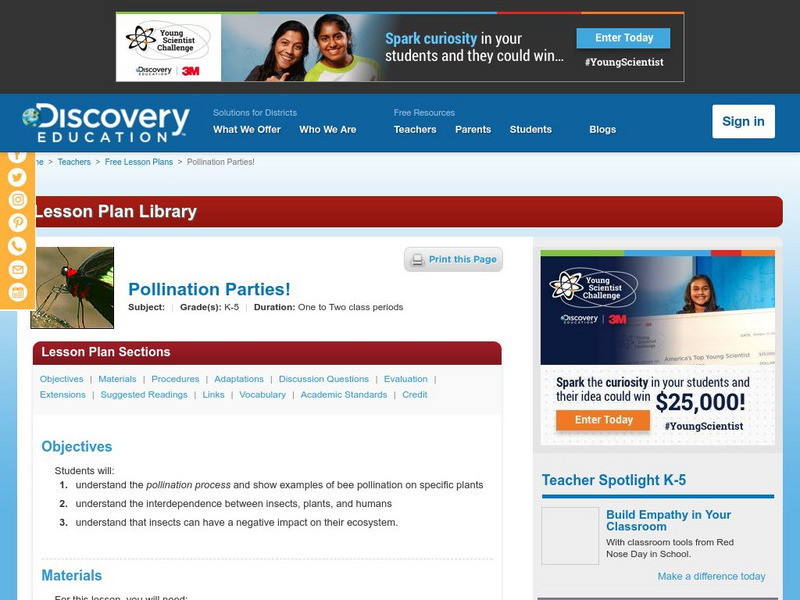Hi, what do you want to do?
Curated OER
Native Beauty
Students plant wild flowers and maintain their garden. In this wild flowers lesson plan, students pick and prepare a gardening site, plant wild flowers, and maintain it everyday.
Curated OER
Making Field Journals
Students follow a bookmaking format to create a book and use it as a garden journal. In this science journal lesson, students follow book making directions to create a garden and science journal.
Curated OER
Exploring Bats
Third graders create a graphic organizer about bats in cooperative groups. The graphic organizer is used to illustrate the information that has been researched. The specific graphic organizer is the KWL.
Curated OER
Catch as Catch Can
Students investigate insects. In this insect analysis lesson, students catch insects using nets they make. They identify the insects they catch and create a chart to show the numbers and varieties. This lesson includes a vocabulary list...
Curated OER
Plant Reproduction
In this plant reproduction worksheet, students complete a crossword puzzle with 36 questions. They identify the different plant reproductive features.
Curated OER
Growing Tomatoes From Seed Activity
In this growing tomatoes worksheet, students plant tomato seeds in February, and follow their growth through the summer break. They observe and investigate the plant growth from seed to plant.
Curated OER
Cinderella: Literacy Skills Packet
In this Cinderella instructional activity packet, students can practice their literacy skills by unscrambling vocabulary words, doing a crossword puzzle, completing a story sequence activity, answering eight short answer questions, and...
Curated OER
Bats are Our Buddies!
In this bats worksheet, students click on the links in the questions about bats to find the answers to the questions and then come back and answer the questions. Students answer 19 questions total.
Curated OER
Pollen Collection And Identification
Students investigate plant reproduction, pollen collection and identification. They collect pollen samples over a twenty four hour period and examine them under a microscope.
Curated OER
The Young Virginia Gardener: Garden Pests and Problems-Insects
In this garden pests and problems activity, learners read about insects and research what insects use their antenna for, comparing 2 or 3 different types.
Curated OER
Spring Collecting and Identifying Bumble Bees
Students collect bumble bees in the field, record data, identify and release specimens, answer conclusion questions, and send data in to researcher leaders. They make research based conclusions based upon the evidence.
Missouri Botanical Garden
Missouri Botanical Garden: Biology of Plants: Pollination
Learn the parts of a flower and how a plant gets pollinated. Includes video, songs, diagrams, and lesson plans.
Starfall
Starfall: All About Seeds
This lesson focuses on seeds and the plants they grow into. It includes kinds and sizes of seeds, pollination of plants, plant parts, how seeds travel, and what plants need to grow.
Discovery Education
Discovery Education: Pollination Parties
This lesson helps students understand the concept of pollination. Objectives, materials, procedures, adaptations, discussion questions, evaluation, extensions, suggested readings, links, vocabulary, and academic standards are all included!
Smithsonian Institution
Smithsonian Learning Lab: Plants and Animals: Partners in Pollination
Smithsonian Education presents a series of three lesson plans whose focus is plants and animals in their role as partners in pollination. Each activity comes complete with clear learning objectives, materials list, subjects covered,...
Other
Nature's Partners: Pollinators, Plants, and You [Pdf]
Teachers will love this comprehensive Grades 3-6 curriculum on pollinators. There are six modules of detailed plans and accompanying materials. Pre-assessment activities and teacher background information, as well as supplemental...
Other
Science and Kids Activities: Pollination and Seed Dispersal
Second graders learn how plants depend on animals to disperse their seeds. Students will learn about ways that animals can disperse seeds. They will design their own model and compare it to the real action of plants and animals. In the...
University of Maryland
University of Maryland: Plant Biology
A webpage for a course on plant biology for non-science majors. The course covers how plants function, diversity among plants, and the roles of plants in the environment. Site includes lectures, a plant project, and a sample exam.
University of Illinois
University of Illinois Extension: Plantenstein Is the Suspect!
Detective Le Plant has discovered that one plant can produce many other plants. He needs you to help him find out how this happens. Follow along and learn about the parts of flowers and reproduction. Along the way, you will be quizzed!
University of Hamburg
University of Hamburg: Deviations From Mendelian Laws And: What Is the Meaning of Dominance?
Upper level discussion of several of Mendel's experiments and laws.
Cornell Lab of Ornithology
Habitat Network: Pollinators at Home: Intro to Pollinator Gardening
Find out how to provide native plants that foster the activity of insects and other pollinators.
CK-12 Foundation
Ck 12: Biology: Flowering Plants
[Free Registration/Login may be required to access all resource tools.] Describes the parts of a flower and the classification and evolution of flowering plants.
Scholastic
Scholastic: Study Jams! Science: Plants: Flowers
A video and a 7-question multiple-choice quiz on the structure and functions of flowers.
Other
Biology: Evolution of Sexual Reproduction
This paper, the work of a Ph.D. researcher, presents an interesting discussion of the reasons that assexual reproduction is not used by most organisms. Toward the end is a specific discussion of reproduction in plants. Advantages and...
























